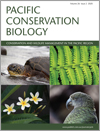
Pacific Conservation Biology
Volume 26 Number 2 2020
This submission was produced at the request of the editor, Professor Mike Calver, to honour the life of the late Adjunct Professor Barbara York Main. The authors of this submission are thankful for the opportunity to create an article in tribute to such an inspiring woman scientist.
PC19016Conservation ecology of Tasmanian coastal saltmarshes, south-east Australia – a review
 , Jamie B. Kirkpatrick, John Aalders, Scott Carver, Joanna Ellison, Violet Harrison-Day, Peter McQuillan, Brigid Morrison, Alastair Richardson and Eric Woehler
, Jamie B. Kirkpatrick, John Aalders, Scott Carver, Joanna Ellison, Violet Harrison-Day, Peter McQuillan, Brigid Morrison, Alastair Richardson and Eric Woehler
A semisystematic literature review supported by expert local knowledge documents existing knowledge on the ecological components, functional relationships and threatening processes of Tasmanian coastal saltmarshes. Research gaps and priorities are identified to assist saltmarsh recovery actions and improve its conservation status.
In this paper I show that the interpretation for an estuarine history of Lake Alexandrina presented in a doctoral thesis (Fluin 2002) and subsequently published in the journal Hydrobiologia (Fluin et al. 2007) was reinterpreted in an unpublished report to a state government (Fluin et al. 2009) without the provision of new evidence or a critique to discount the findings of the original paper. This new interpretation argues that the lake has been predominantly fresh for 7000 years and this revised finding has been widely cited in the literature and online discussions and used by governments to advocate for a freshwater future for the Lower Lakes.
PC18085 Abstract | PC18085 Full Text | PC18085PDF (534 KB) | PC18085Corrigendum (534 KB) Open Access Article
The lower lakes of the River Murray are some of the most ecologically important wetlands in Australia. This work assessed whether Lake Alexandrina and Lake Albert were predominantly fresh over their history. An analysis of previously published work indicates that over most of their history and most of their area Lake Alexandrina and Lake Albert were fresh.
PC19039 Abstract | PC19039 Full Text | PC19039PDF (386 KB) Open Access Article
This study investigates, and provides information useful for the conservation assessment of, the endemic and Data Deficient Tagula butcherbird (Cracticus louisiadensis). Research benefits came from the species’ high cultural value among local residents. This forest-dependent species remains vulnerable and was found to be restricted to four remote islands in the Louisiade Archipelago (Papua New Guinea).
This research examines patterns of woody plant species richness and structure in dry forests on the three largest islands in the Galápagos. We identify the conservation status of woody plants within the dry forest region, assess forest cover change, and compare results to other tropical dry forests in the Pacific.
Threatened species possess many traits that make them highly vulnerable to climate change. We reviewed the conservation assessments for listing species and communities in NSW, Australia, and found only 13% of species and 24% of ecological communities had climate change identified as a threat. These estimates are likely conservative, suggesting that biodiversity management at the landscape-scale may be more effective than targeted, single-species management actions.
PC19023Averting danger under the bridge: video confirms that adult small-toothed morays tolerate salinity before and during tidal influx
 , James A. Donaldson
, James A. Donaldson  , Robert Courtney, Richard Fitzpatrick, Danswell Starrs, Cameron S. Fletcher and Jamie Seymour
, Robert Courtney, Richard Fitzpatrick, Danswell Starrs, Cameron S. Fletcher and Jamie Seymour
Remote underwater video, snorkel and above-water observations of morays, combined with salinity measurements, reveal that the small-toothed moray, Gymnothorax polyuranodon, is capable of tolerating salinity of at least 14.4 for approximately an hour, and can inhabit salinity of 19 for a period of several minutes.
PC19019Countering low visibility in video survey of an estuarine fish assemblage
 , Paulo Drews Jr, Michael Bradley, David L. Morgan, Ronald Baker and Brendan C. Ebner
, Paulo Drews Jr, Michael Bradley, David L. Morgan, Ronald Baker and Brendan C. Ebner 
Tropical estuaries can be challenging and dangerous places to survey fish communities. Underwater video provides an alternative to traditional survey methods, however poor water clarity can impact the effectiveness of video surveys. We demonstrate how image enhancement techniques can improve identification of fish species from video in reduced visibility conditions.
Field-based video recording of courtship between a male and female Stiphodon semoni (Family Gobiidae) afforded the opportunity to discern specific behaviours not reported of sicydiine gobies previously, including tail-wagging and kiss-like behaviour by the male.
PC19001Extension of the historic range of Pristis pristis on the east coast of Australia
Sawfish conservation status is of increasing concern as populations have disappeared from much of their historical range. The usefulness of historic articles containing the generic term ‘sawfish’ was assessed and the historic range for the species Pristis pristis was extended.
PC19008Two years of impairment: plastic packing strap on a bull shark (Carcharhinus leucas) in Fiji
Plastic straps have been recorded from single point in time observations in various shark species. Here, we report a bull shark with a plastic strap around its head from the time of acquisition until its loss after two years.
PC18085_COCorrigendum to: Watching the tide roll away – contested interpretations of the nature of the Lower Lakes of the Murray Darling Basin
PC18085_CO Abstract | PC18085_COCorrigendum (534 KB) Open Access Article



